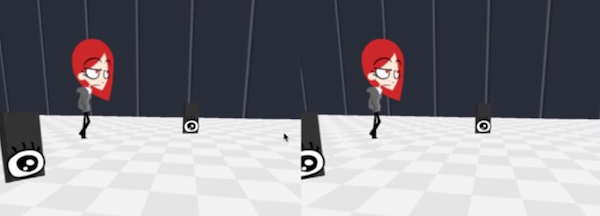Again, another deceptively simple thing that blew my skepticism out of the water. This time, it's Windy Day. (created by Pixar animators, apparently!) I've seen more technically & graphically impressive VR films/games before, but it was this one that made me realize - holy crap, this is an actually interesting art medium to explore!
Because previously, I'd only focused on the one big thing you can't do in VR films, compared to regular films: you can't control where the viewer looks at. And so, that seemed to be a huge sacrifice for the sake of "ooh you're really there". (Side note: I think it's a bit insulting to people's imagination & empathy, to think they can't be immersed in a world without putting them in a literal first-person perspective)
But in Windy Day, they took that "constraint", and used it to enhance the film.
Camera-control as comedy:
This maybe be something that only animators notice. But you know how in those old classic cartoons, a character will chase a thing, and the camera follows, then the character hits a wall, but the camera has inertia, and zips past a lot, before springing back?
Well, that's you in Windy Day. You are the camera, and you have inertia. The film makes you unwittingly CREATE the comedy.
Impossible geometry as scene transitions:
I only noticed this on my tenth replay of Windy Day, coz that's how subtle it is. The world changes around you when you're not looking. In the beginning, it's all trees and forest, but a while later, there's a patch of grassland that wasn't there before. That is a really subtle way to do a scene transition.
(And in the full version of Windy Day, it's less subtle, but it's still how all the scene transitions are done smoothly - with impossible geometry)
Head movement as blocking:
This Every Frame a Painting episode does a great job of explaining how blocking works wonders in a long-cut shot. And Windy Day is nothing but one giant long cut. Surround-space theatre. (Will all VR films be like that? Mostly long cuts?)
It's pretty simple. Want the viewer to look at two different things, but not at the same time? Place them at far apart angles relative to the camera. (not necessarily distance) Want a closeup? Have all characters walk closer to the camera. Want something to happen "offscreen"? Distract the viewer to look away, then have them look back.
Think of one of the most common film techniques: shot-reverse-shot. A shot of someone looking past the camera, a shot of what they're looking at, a shot of their reaction. With VR, you just need to change your head's angle to create the shot-reverse-shot yourself!
Practical use of non-photorealism:
Totally personal taste, but I find photorealism to be boring and aesthetically lazy. You have all the possible styles in the world to choose from, and you choose... the one that's literally surrounding us all the time?
But for Google Cardboard, there's a practical reason to be non-photorealistic! The graphical & rendering quality isn't going to be as good as an Oculus, so, one really shouldn't try to get super-high-rez, high-polygon graphics on a Cardboard. It'll just look bad.
But something as stylistic as Windy Day? Perfect.
The action waits for you:
What if something happens and the viewer's not looking? is a pretty valid question. And, after testing Windy Day over and over, I found their solution to this answer to be brilliantly simple. Just wait until the viewer's looking.
Here's what they do: if you're not looking where you're supposed to, the characters just play a loop in the spot they're at, until you look back. The music, if there is any, also loops. (but also gets quieter if you're looking at the wrong spot)
Guiding the head:
Windy Day also guides you smoothly with motion and audio. It's pretty basic what they do - just follow the things that are moving, and the audio lowers if you're not looking at the right spot.
But here's some thoughts on other ways to guide the head, that I didn't see in Windy Day. Using stereo audio to get the viewer to look left/right. Using sharply contrasting light to guide viewers to the light. Things appearing from offscreen, making you want to look in that direction. And so on, who knows!
Questions for VR filmmaking:
Should the camera move? A third-person camera stays still in Windy Day, but another third-person camera moves in Lucky's Tale, and both work fantastically well.
Should the camera be in first-person? The only not-weird-feeling VR demos I've seen in first-person (and most demos are first-person, "ooh you're really there") are ones where the camera is still. Having the player look around naturally, but move with a controller just feels weird.
How do we do cuts and transitions? With VR films, sometimes cuts feel weird, sometimes they don't. I haven't tried enough to know when they're weird or not. How would transitions work? Impossible geometry? Simple fade-to-black? Would fading scenes look weird in VR, since it won't seem like fading images, it'd seem like the whole world is fading?
In summary, the biggest thing to remember in VR filmmaking: the viewer is co-creating the movie. And you've got to guide their eyes and head, with as much leeway as you can get away with. Don't worry, it's not a problem unique to VR - theatre, comics, infographics... all visual artists face the problem of guiding-the-eye, to different degrees. This problem's already half-solved.
But that's enough talk.
This all excites me, so I'm going to put my currency where my words-hole is, and make a short 2.5D virtual reality film.

(from a Google Cardboard test I did a while back)
At the worst, it'd be a very interesting failure.
